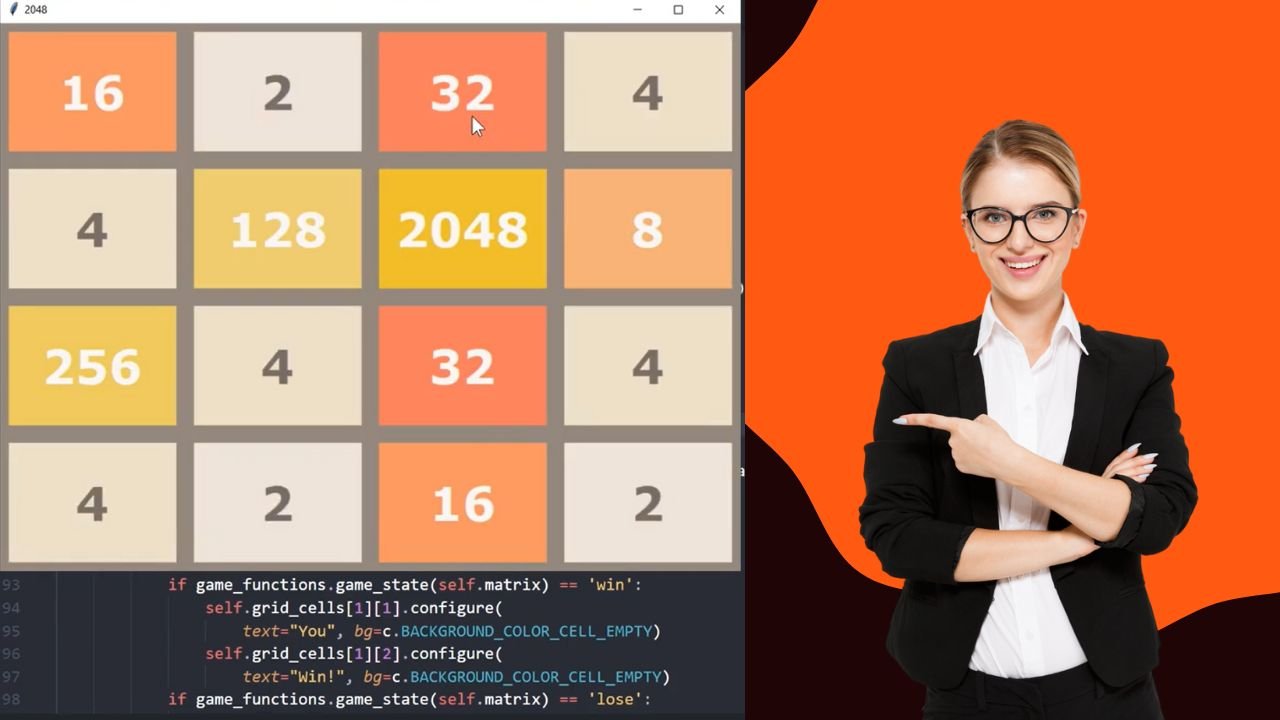Introduction
2048 ek game hai jo dekhnein mein to bohot hi simple lagta hai, lekin highly addictive hai. Iskey objective mein numbered tiles ko ek 4×4 grid pe slide karke combine karna aur 2048 ka tile banane ka hai.
Shuru mein bohot hi easy lagta hai, lekin jaise jaise board fill hone lagta hai, yeh game challenging ho jata hai.
Despite the popularity of this game, even the best human players ko struggle karna padhta hai to consistently reach the 2048 tile, let alone higher numbers.
Yahan pe (AI) enters the scene.
Recent years mein, AI researchers and enthusiasts ne aise algorithms develop kiye hain jo 2048 ko superhuman level pe khel sakte hain, achieving scores and tile values jo pehle impossible lagte the.
The Basics of 2048 AI
2048 AI ke basics ye hain ki yeh ek computer program hai jo current state of the game board ke hisaab se decide karta hai ki konsa move karna hai.
Yeh AI tiles ki positions aur values ko dekhta hai aur evaluate karta hai ki char moves (up, down, left, right) mein se konsa move high score lane mein madat karega.
Early 2048 AIs heuristics pe rely karte the – ye predefined rules aur strategies hoti hain jo decision-making process ko guide karti hain.
For example, ek common heuristic yeh hai ki highest-value tile ko ek corner mein rakho aur uske bagal mein monotonically increasing row banao.
Ye rules follow karke, AIs consistently game jeet lete the aur 2048 tile tak pohochte the.
Lekin heuristics sirf itna hi le ja sakti hain. 2048 ko truly master karne aur stratospheric scores lane ke liye, AIs ko hard-coded strategies se aage jaana pada aur experience se seekhna pada.
See Also: What is Intellimali
Advanced AI Techniques
Advanced AI techniques ki baat karein to, ek sabse successful approach hai expectimax search.
Instead of sirf immediate result of each move consider karne ka, expectimax multiple moves ahead dekhta hai aur calculate karta hai average (expected) score over all possible random tile spawns ka.
Deeper search kar ke, yeh AI woh moves dhoondh leta hai jo immediately to benefit nahi karte, but long run mein better position le aate hain.
Ek aur powerful technique hai Monte Carlo tree search (MCTS). MCTS current position se bahut saare games simulate karta hai, gradually ek “search tree” of promising moves banaata jaata hai.
Time ke saath, AI discover kar leta hai ki konse moves consistently high scores le aate hain aur apna search unhi branches pe focus kar deta hai.
Current state-of-the-art 2048 AIs expectimax, MCTS aur n-tuple networks aur temporal difference learning jaise advanced techniques ka combination use karti hain.
Millions of simulated games pe train karke, ye AIs pehle unthinkable maane jaane wale milestones jaise 32768 tile aur 800,000 se zyada scores tak pohoch gaye hain.
See Also: ParaphraseTool.ai: Best Quillbot Alternative in 2024
Superhuman Achievements
2048 AIs ki baath karein to ye insaano se bilkul alag level pe hain.
Current human world record for 2048 sirf 1,353,292 points ka hai, China ke ek player ne banaya tha.
Lekin AI scores 1,000,000 points se bhi zyada aage nikal gaye hain, currently record 2,444,356 points ka hai.
AIs bohot zyada upar ke tile values bhi achieve kar lete hain, 65536 tile (2^16) to routine ho gaya hai unke liye.
Sabse impressive baat ye hai ki top 2048 AIs 32768 tile (2^15) ko over 70% success rate se achieve kar lete hain.
Compare karein to even the best human players struggle karte hain 16384 tile (2^14) ko ek hi game mein laane ke liye. In AIs ki consistency aur skill mind-boggling hai.
Scaling to Larger Board Sizes
jab 4×4 standard board size se aage badhke larger board sizes ki baat aati hai, jaise 10000×10000, to ye AI agents ke liye ek additional challenge ban jaata hai kyunki search space aur computational complexity exponentially increase ho jaati hai.
Aise larger board sizes ke liye, researchers ne kuch techniques propose kiye hain:
- Pruning aur Heuristic Improvements: Heuristic evaluation functions ko enhance karna aur search tree ko zyada aggressively prune karna ta ki computational burden kam ho.
- Parallel and Distributed Computing: Parallel aur distributed computing architectures ka use karke search workload ko multiple processors ya machines pe distribute kar dena.
- Hierarchical Approaches: Bade board ko chhote sub-boards mein divide karke hierarchical search ya reinforcement learning techniques apply karna.
- Approximation Techniques: Monte Carlo sampling ya neural networks jaise approximation methods ka use karke board states ke values ko exhaustive search kiye bina estimate kar lena.
- Specialized Hardware: Graphics processing units (GPUs) ya field-programmable gate arrays (FPGAs) jaise specialized hardware ka use karke larger board sizes ke liye required computations ko accelerate karna.
Ye note karna zaroori hai ki AI agents ko extremely large board sizes jaise 10000×10000 tak scale karna abhi bhi ek badhiya challenge hai, aur is mein aur research ki zaroorat hai ki efficient aur effective algorithms develop kiye jaa sakein aise scenarios ke liye.
See Also: AI Willy Wonka Disaster Scotland
Conclusion
2048 game ne kai AI techniques ke liye ek interesting testbed provide kiya hai, jaise search algorithms, reinforcement learning, aur heuristic evaluation functions.
Jyadatar research standard 4×4 board size pe hi focus karti rahi hai, lekin kuch studies larger board sizes jaise 10000×10000 pe bhi explore kar rahi hain by pruning, parallel computing, hierarchical approaches, approximation methods, aur specialized hardware jaisi techniques ka use karke.
Lekin extremely large board sizes ke liye efficient aur effective AI agents develop karna artificial intelligence field mein ek ongoing challenge hi rahega.
